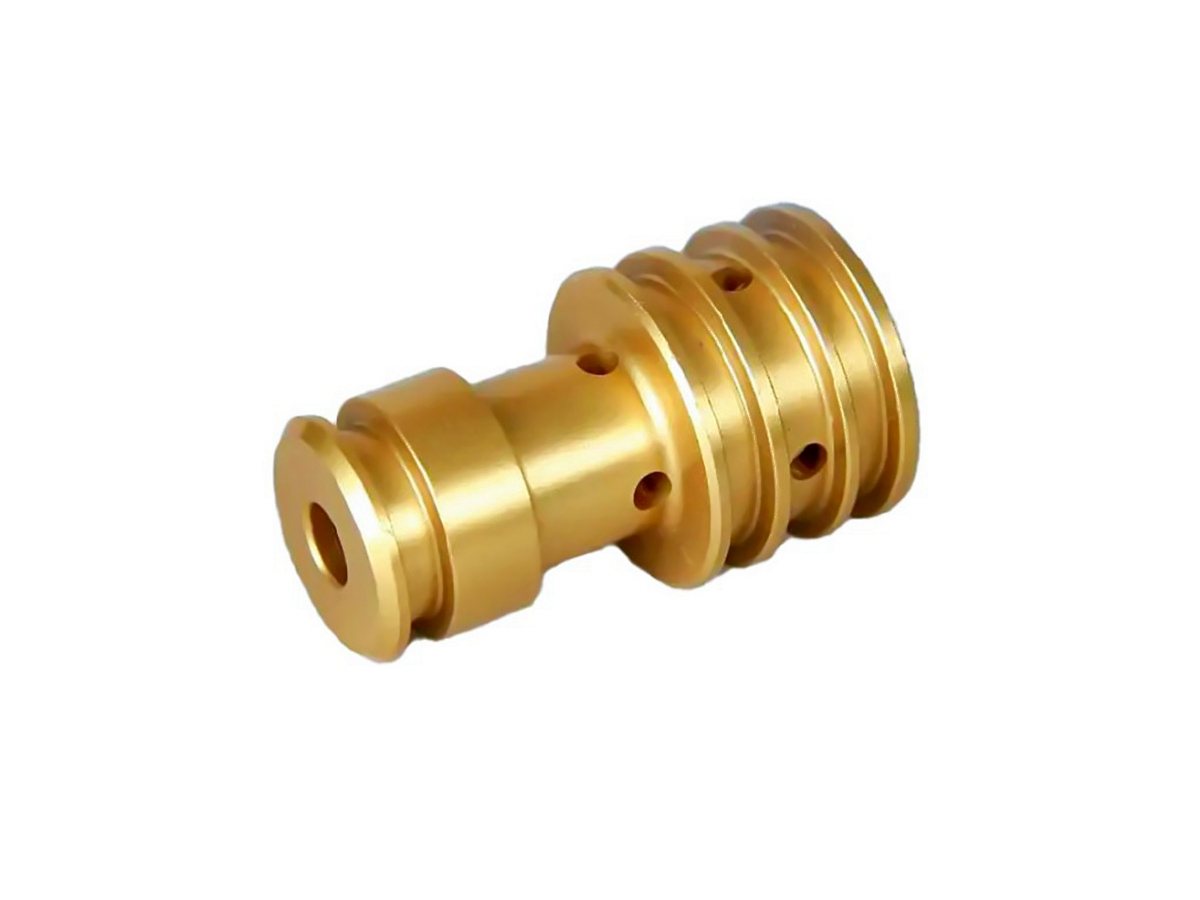Brass C624 for High-Strength Aerospace Parts CNC Machining On-demand Manufacturing
Introduction
The aerospace industry demands materials with exceptional strength, corrosion resistance, reliable machinability, and consistent performance under extreme conditions. Brass C624 (Aluminum Bronze) is particularly suitable for aerospace components due to its high tensile strength (up to 655 MPa), excellent corrosion resistance, wear resistance, and ability to withstand demanding environments. These features make Brass C624 an ideal choice for aerospace applications such as landing gear bushings, bearing retainers, structural fittings, and precision mechanical parts.
By leveraging advanced CNC machining, aerospace manufacturers can precisely produce complex Brass C624 parts tailored for on-demand manufacturing with strict tolerances, high-quality surface finishes, and consistent repeatability. CNC machining ensures dimensional accuracy, reliability, and component integrity critical to aerospace safety and performance.
Brass C624 for Aerospace Applications
Material Performance Comparison
Material | Tensile Strength (MPa) | Yield Strength (MPa) | Corrosion Resistance | Typical Applications | Advantage |
|---|---|---|---|---|---|
585-655 | 240-310 | Exceptional (Marine & Aerospace Grade) | Landing gear bushings, structural fittings | High strength, corrosion & wear resistant | |
340-470 | 170-310 | Good | Aerospace connectors, fittings | Excellent machinability | |
950-1000 | 880-950 | Outstanding | Structural components, fasteners | Excellent strength-to-weight ratio | |
930-1100 | 790-1000 | Excellent | Aerospace shafts, gears | Superior strength and toughness |
Material Selection Strategy
Selecting appropriate aerospace materials involves assessing mechanical strength, corrosion resistance, machinability, and specific application requirements:
Landing gear bushings, structural fittings, and bearing retainers requiring high strength (585-655 MPa), excellent corrosion resistance, and durability significantly benefit from Brass C624, optimizing reliability under extreme operating conditions.
Aerospace connectors, precision fittings, and less demanding components needing good machinability and moderate strength (340-470 MPa) often use Brass C360, offering cost-effectiveness and efficient production.
Structural components, fasteners, and critical aerospace parts demanding superior strength-to-weight ratio (950-1000 MPa tensile) typically select Titanium Grade 5 (Ti-6Al-4V), enhancing performance while minimizing weight.
Aerospace shafts, gears, and high-stress components requiring exceptional strength (930-1100 MPa tensile) and toughness prefer Stainless Steel 17-4PH, ensuring long-term reliability and resistance to fatigue.
CNC Machining Processes
Process Performance Comparison
CNC Machining Technology | Dimensional Accuracy (mm) | Surface Roughness (Ra μm) | Typical Applications | Key Advantages |
|---|---|---|---|---|
±0.01-0.02 | 0.8-1.6 | Bushings, rotational fittings | Precise cylindrical components, fast production | |
±0.005-0.01 | 0.4-0.8 | Complex structural fittings, brackets | High accuracy, intricate geometry | |
±0.01-0.03 | 1.6-3.2 | Precision holes, aerospace fittings | Rapid machining, accurate positioning | |
±0.002-0.01 | 0.1-0.4 | Precision bearing surfaces, mating parts | Superior precision, high-quality surface finish |
Process Selection Strategy
Choosing CNC machining processes for Brass C624 aerospace parts depends on the complexity, precision requirements, and specific functional demands:
Bushings, rotational fittings, and cylindrical components requiring moderate precision (±0.01-0.02 mm) efficiently use CNC Turning, ensuring fast production and consistent dimensional accuracy.
Complex structural fittings, brackets, and highly detailed aerospace components demanding tight tolerances (±0.005-0.01 mm) and intricate geometries significantly benefit from 5 Axis CNC Milling, maximizing precision and component integrity.
Precision holes, threaded fittings, and basic aerospace hardware requiring quick and accurate machining (±0.01-0.03 mm) utilize CNC Drilling, effectively enhancing production efficiency.
High-precision bearing surfaces, mating components, and critical parts needing ultra-tight tolerances (±0.002-0.01 mm) and superior surface finishes (Ra ≤0.4 μm) employ CNC Grinding, ensuring optimal performance and reliability.
Surface Treatment
Surface Treatment Performance
Treatment Method | Corrosion Resistance | Wear Resistance | Max Operating Temp (°C) | Typical Applications | Key Features |
|---|---|---|---|---|---|
Outstanding (≥1200 hrs ASTM B117) | High | Up to 300 | Structural fittings, landing gear parts | Durable oxide coating, improved corrosion protection | |
Exceptional (≥1200 hrs ASTM B117) | Very High | Up to 250 | Wear-prone parts, bushings | Superior hardness, uniform coating | |
Excellent (~1000 hrs ASTM B117) | Moderate | Up to 200 | Internal aerospace components | Surface purity, excellent corrosion resistance | |
Exceptional (~1200 hrs ASTM B117) | Excellent | Up to 400 | Aerospace fasteners, precision surfaces | Superior wear resistance, enhanced durability |
Surface Treatment Selection
Selecting surface treatments for Brass C624 aerospace components involves considerations of corrosion protection, mechanical performance, and environmental conditions:
Structural fittings and landing gear parts demanding excellent corrosion protection and improved wear resistance significantly benefit from Anodizing, ensuring long-term durability and corrosion resistance.
Wear-prone components such as bushings, bearing retainers, and mechanical parts benefit from Electroless Nickel Plating, which provides exceptional hardness and consistent protection against corrosion and abrasion.
Internal aerospace components, precision fittings, and intricate internal mechanisms requiring reliable corrosion resistance choose Passivation, enhancing component integrity and lifespan.
Aerospace fasteners, critical precision surfaces, and highly stressed components benefit significantly from advanced PVD Coatings, offering excellent wear resistance, durability, and thermal stability.
Quality Control
Quality Control Procedures
Precision dimensional inspections using Coordinate Measuring Machines (CMM) and optical comparators.
Surface roughness measurements with high-accuracy profilometers.
Mechanical property testing (tensile, hardness, fatigue) according to ASTM and aerospace industry standards.
Corrosion resistance evaluations using ASTM B117 (Salt Spray Test).
Non-destructive testing (NDT), including ultrasonic, X-ray, and fluorescent penetrant inspections.
Detailed traceability documentation conforming to ISO 9001 and AS9100 aerospace quality management systems.
Industry Applications
Brass C624 Aerospace Component Applications
Landing gear bushings and bearing retainers.
Structural fittings and precision mechanical parts.
Aerospace connectors and brackets.
High-performance aerospace valves and components.
Related FAQs:
Why is Brass C624 ideal for high-strength aerospace applications?
How does CNC machining support on-demand aerospace manufacturing?
Which aerospace parts commonly use Brass C624?
What surface treatments enhance the performance of Brass C624 aerospace components?
What aerospace quality standards apply to CNC machining of Brass C624 components?

